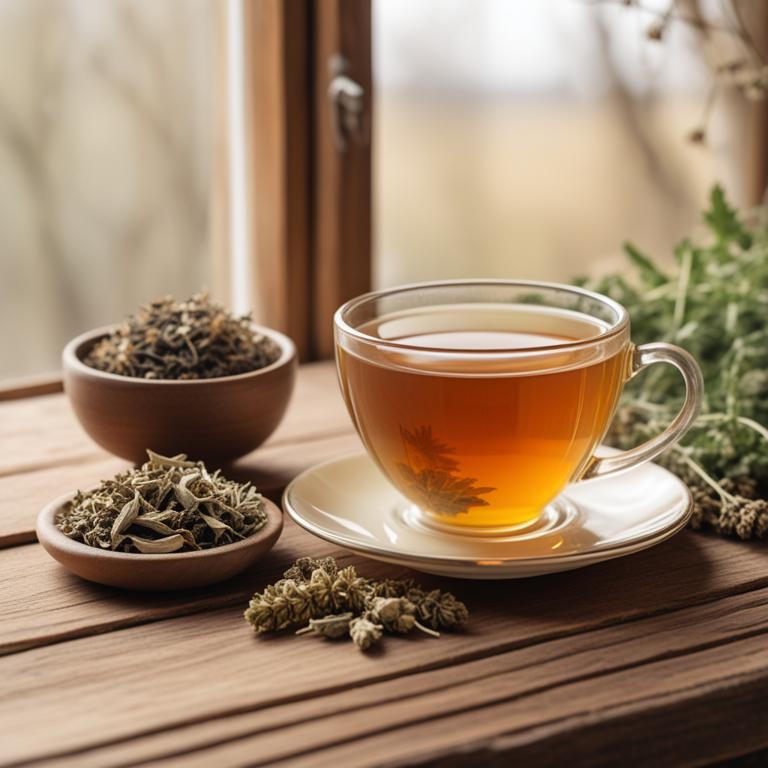9 Herbal Teas For Nausea

Herbal teas have been used for centuries to help alleviate nausea.
These teas work by soothing the stomach and reducing inflammation, making them a natural and effective solution for people who experience nausea. One of the main reasons herbal teas are so effective is that they contain active compounds that interact with the body's natural processes to calm the stomach. For example, Zingiber officinale, also known as ginger, is a popular herbal tea that has been shown to reduce nausea and vomiting in pregnant women and people undergoing chemotherapy. Ginger contains compounds called gingerols and shogaols, which have anti-inflammatory properties that help to calm the stomach and reduce nausea.
Foeniculum vulgare, or fennel, is another herb that is commonly used to relieve nausea. Fennel contains compounds called anethole and fenchone, which have a calming effect on the stomach and can help to reduce nausea and bloating. Glycyrrhiza glabra, or licorice root, is another herb that has been used for centuries to relieve nausea. Licorice root contains compounds called glycosides, which have anti-inflammatory properties that can help to soothe the stomach and reduce nausea. Drinking herbal teas like ginger, fennel, and licorice root can be incredibly beneficial for people who experience nausea.
Not only can they help to alleviate symptoms, but they can also be a natural and effective way to manage nausea without relying on medication.
- 1. Zingiber officinale
- 2. Foeniculum vulgare
- 3. Glycyrrhiza glabra
- 4. Mentha x piperita
- 5. Cinnamomum verum
- 6. Ginkgo biloba
- 7. Lavandula angustifolia
- 8. Angelica archangelica
- 9. Piper nigrum
1. Zingiber officinale

Zingiber officinale teas contains compounds like gingerol and shogaol, which are responsible for its medicinal properties.
These compounds have anti-inflammatory properties that help to reduce nausea and vomiting. Gingerol and shogaol also have natural pain-relieving properties that can help to alleviate the discomfort associated with nausea. The compounds in ginger also have a sedating effect on the digestive system, which can help to calm the stomach and reduce the sensation of nausea.
By reducing inflammation and calming the digestive system, Zingiber officinale teas can help to alleviate nausea and provide relief.
- Boil 1 cup of water in a kettle or on the stove.
- Measure 1/2 teaspoon of dried Zingiber officinale root powder or 2-3 slices of fresh root into a tea infuser or a small piece of cheesecloth.
- Pour the boiling water over the Zingiber officinale root in the tea infuser or cheesecloth.
- Steep for 5-7 minutes to allow the flavors to release. Strain the tea if using cheesecloth.
- Drink the tea slowly while it's still warm to help alleviate nausea.
Zingiber Officinale Tea on Amazon
FGO Organic Ginger Tea, 100 Count, Eco-Conscious Tea Bags, Caffeine Free, Packaging May Vary (Pack of 1)
Disclaimer: We earn a commission if you click this link and make a purchase at no additional cost to you.
2. Foeniculum vulgare

Foeniculum vulgare teas contains a compound called anethole, which has natural anti-inflammatory properties that help soothe the stomach.
Another key constituent, fenchone, has a sedative effect that can calm the digestive system and reduce nausea. The tea also has a high concentration of antioxidants, which can help protect the stomach lining and reduce inflammation. The essential oils in Foeniculum vulgare tea, including anethole and limonene, have been shown to have a relaxing effect on the digestive system, reducing symptoms of nausea and vomiting.
By reducing inflammation and promoting relaxation, Foeniculum vulgare tea can help alleviate nausea and provide relief.
- Gather 1 teaspoon of dried Foeniculum vulgare (fennel seeds) and a cup of water.
- Heat the water in a pot until it reaches a boil.
- Add the fennel seeds to the boiling water and let it simmer for 5 minutes.
- Strain the liquid into a cup and discard the fennel seeds.
- Drink the tea as needed to help with nausea, but do not exceed 2 cups per day.
3. Glycyrrhiza glabra

Glycyrrhiza glabra teas contains bioactive constituents such as glycyrrhizin, flavonoids, and triterpenoids.
These compounds have anti-inflammatory and antioxidant properties that help reduce nausea. Glycyrrhizin, in particular, has been shown to inhibit the activity of 11-beta-hydroxysteroid dehydrogenase, an enzyme involved in the production of cortisol, a hormone that can exacerbate nausea. The flavonoids and triterpenoids in Glycyrrhiza glabra teas have also been found to have a soothing effect on the digestive system, which can help alleviate nausea and vomiting.
By reducing inflammation and promoting a healthy digestive environment, Glycyrrhiza glabra teas can provide relief from nausea.
- Gather ingredients: 1 cup of water, 1 teaspoon of dried Glycyrrhiza glabra root, and a strainer.
- Boil the water in a pot.
- Add the dried Glycyrrhiza glabra root to the boiling water.
- Reduce heat and let it simmer for 5-7 minutes, then strain the mixture.
- Drink 1/2 cup of the tea as needed to help with nausea.
4. Mentha x piperita

Mentha x piperita teas contains bioactive constituents like menthol and menthone that have anti-inflammatory properties.
These properties help to reduce inflammation in the digestive tract, which can contribute to nausea. The carvone in Mentha x piperita also has a sedative effect, which can help to calm the stomach and reduce nausea. Additionally, menthol has a natural anesthetic effect that can help to numb the stomach and reduce discomfort.
By reducing inflammation and discomfort, Mentha x piperita teas can help to alleviate nausea.
- Gather 1 tablespoon of dried Mentha x piperita leaves (peppermint) or 2 tablespoons of fresh leaves.
- Heat 1 cup of water in a pot until it boils.
- Remove the pot from heat and add the dried or fresh peppermint leaves.
- Let the leaves steep in the water for 5-7 minutes, then strain the liquid using a tea strainer or cheesecloth.
- Drink 1/2 cup to 1 cup of the peppermint tea as needed to help relieve nausea.
5. Cinnamomum verum

Cinnamomum verum teas contains essential oils like cinnamaldehyde, linalool, and eugenol, which have anti-inflammatory properties that help reduce nausea.
Cinnamaldehyde, in particular, has been shown to have a positive effect on the digestive system by reducing spasms and inflammation in the stomach. Eugenol has a sedative effect on the nervous system, which can help calm digestive issues and reduce nausea. The anti-inflammatory properties of these oils help to relax the muscles in the stomach, reducing nausea and discomfort.
Regular consumption of Cinnamomum verum teas has been linked to improved digestion and reduced nausea in people with digestive issues.
- Gather 2 teaspoons of Cinnamomum verum (Ceylon cinnamon) sticks and 1 cup of water.
- Crush the cinnamon sticks into small pieces using a spoon.
- Boil the cup of water in a saucepan.
- Add the crushed cinnamon pieces to the boiling water and let it simmer for 5 minutes.
- Strain the mixture and drink as a tea to help with nausea.
6. Ginkgo biloba

Ginkgo biloba teas contains bioactive constituents like flavonoids and terpenoids.
These compounds have anti-inflammatory and antioxidant properties that help to reduce nausea by soothing the stomach and intestines. Ginkgo biloba also contains bilobalide and ginkgolides, which have a protective effect on the stomach lining and can help to prevent stomach upset. The antioxidants in ginkgo biloba teas can also help to reduce inflammation in the digestive tract, making it easier to manage nausea.
By reducing inflammation and soothing the stomach, ginkgo biloba teas can provide relief from nausea and help to promote a sense of calm.
- Gather 1 cup of boiling water and 1 teaspoon of dried Ginkgo biloba leaves.
- Measure 1 teaspoon of dried Ginkgo biloba leaves into a tea infuser or a small muslin bag.
- Pour the boiling water over the Ginkgo biloba leaves and let it steep for 5-7 minutes.
- Strain the tea into a cup and discard the leaves. Add honey or lemon to taste, if desired.
- Drink the tea 2-3 times a day to help alleviate nausea.
7. Lavandula angustifolia

Lavandula angustifolia teas contains linalool and linalyl acetate, two active constituents that help with nausea.
These compounds have a calming effect on the stomach and digestive system, reducing inflammation and soothing any irritation. Linalool also has a sedative property, which can help to calm the body and mind, further reducing nausea. The antispasmodic properties of linalyl acetate help to relax the muscles in the stomach, preventing spasms that can cause nausea.
Drinking Lavandula angustifolia tea may also help to regulate digestion and reduce the severity of nausea symptoms.
- Get 1 cup of boiling water and a tea infuser or a heat-resistant cup.
- Add 1-2 teaspoons of dried Lavandula angustifolia flowers to the tea infuser or the cup.
- Steep the flowers in the boiling water for 5-7 minutes, then remove the infuser or cup from the heat.
- Strain the tea into another cup and discard the flowers. Add honey or lemon to taste, if needed.
- Drink the tea slowly and see if it helps with nausea. You can repeat as needed, but not more than 3-4 times a day.
8. Angelica archangelica

Angelica archangelica teas contains compounds like angelan and furofuran lignans.
These bioactive constituents have anti-inflammatory properties that can help reduce stomach upset. The tea also has a soothing effect due to the presence of sesquiterpenes like bergamotene and bisabolol, which can calm the stomach and alleviate nausea. The anti-spasmodic properties of furofuran lignans can also help ease cramps and discomfort associated with nausea.
By reducing inflammation and calming the stomach, Angelica archangelica teas may provide relief from nausea.
- Gather 2 tablespoons of dried Angelica root and 1 cup of boiling water.
- Place the Angelica root in a heat-resistant cup or mug.
- Pour the boiling water over the Angelica root.
- Steep for 5-7 minutes, then strain the tea into another cup.
- Drink the tea as needed, up to 3 times a day, for nausea relief.
9. Piper nigrum

Piper nigrum teas contains a compound called piperine, which is a strong antioxidant.
This antioxidant helps to reduce inflammation in the stomach, making it a natural remedy for nausea. Piperine also has anti-spasmodic properties, which can help to calm stomach muscles and reduce cramps. The terpenes in Piper nigrum, such as limonene and beta-pinene, have been shown to have anti-inflammatory effects and can help to soothe the stomach.
By reducing inflammation and calming stomach muscles, Piper nigrum teas may help to alleviate nausea and provide relief from stomach discomfort.
- Measure 1 tablespoon of dried Piper nigrum seeds.
- Add 1 cup of boiling water to a cup.
- Add the measured Piper nigrum seeds to the boiling water.
- Steep for 5-7 minutes, then strain the mixture.
- Drink the tea when it's warm, 2-3 times a day for nausea relief.